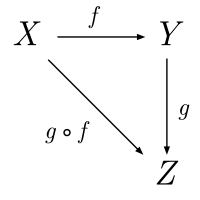Theori categori
Mae theori categori (neu ddamcaniaeth categori) yn ffurfioli strwythur mathemategol a'i gysyniadau yn graff wedi'i gyfeirio â labeli a elwir yn "gategori", y mae ei nodau'n cael eu galw'n "wrthrychau", a gelwir yr ymylon yn "saethau", neu'n "morffismau". Mae gan gategori ddwy nodwedd sylfaenol: y gallu i gyfansoddi'r saethau cysylltiol, ac yn ail, bodolaeth "saeth unfathiant" ar gyfer pob gwrthrych. Defnyddiwyd iaith theori categori i ffurfioli cysyniadau megis setiau, cylchoedd a grwpiau. Yn anffurfiol, mae theori categori yn theori gyffredinol o ffwythiannau.[1][2]
 | |
| Enghraifft o'r canlynol | maes o fewn mathemateg |
|---|---|
| Rhan o | higher category theory, theory of sets, relations and functions |
| Yn cynnwys | category theory terminology |

O fewn theori categori, mae ystyr gwahanol i rai o'r termau, megis "morffism" - pur wahanol i'r defnydd arferol o fewn gweddill mathemateg. Mae morffismau'n ufuddhau i amodau sy'n unigryw i theori categori.
Cyflwynodd Samuel Eilenberg a Saunders Mac Lane y cysyniadau o gategorïau, gweithredyddion (functors) a thrawsffurfiadau naturiol rhwng 1942 a 1945 yn eu hastudiaeth o topoleg algebraidd, gyda'r nod o ddeall prosesau strwythur mathemategol.
Fe'i cymhwysir i theoriau eraill megis theori iaith rhaglennu e.e. y defnydd o monads. Caiff hefyd ei defnyddio ar gyfer sylfaen gwirebol ar gyfer mathemateg - dewis arall i'r theori setiau arferol.[3]
Gweler hefyd
golygu- ↑ Awodey, Steve (2010) [2006]. Category Theory. Oxford Logic Guides. 49 (arg. 2nd). Oxford University Press. ISBN 978-0-19-923718-0.
- ↑ Geroch, Robert (1985). Mathematical physics (arg. [Repr.]). Chicago: University of Chicago Press. tt. 7. ISBN 978-0-226-28862-8.
Note that theorem 3 is actually easier for categories in general than it is for the special case of sets. This phenomenon is by no means rare.
- ↑ B. Coecke, editor New Structures for Physics Number 831 in Lecture Notes in Physics. Springer-Verlag, 2011